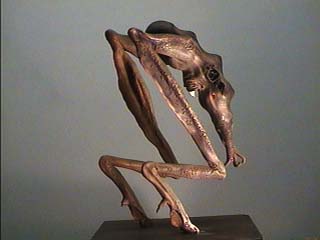What would happen if a bunch of big names in planetary science, anthropology, and science fiction all got together for a big worldbuilding confab? Once a year?
The explosion of awesome known as COTI - Cultures Of The Imagination.
 |
| Pictured: COTI logo, featuring a human skull and an alien skull. |
It's pretty epic to read about the results of each yearly conference, though I get the impression it's been happening every year since 1983; so why are only the first 4 years' worth of findings viewable on their site?
Oh well. It's still pretty awesome. Each conference summary details an effort to construct an alien world with a sentient species, followed by an effort to roleplay first contact between these aliens and human explorers. We get to see the Alchemists, an aquatic species from an icy ocean world, the Squiches, guys with really long legs, and the Mossbacks of the planet Ophelia, living below a perpetual cloud layer. Also, flying dolphins.



Left to right: Alchemist, Squich, Mossback (Artwork by Joel Hagen)
There's also an article labeled "The Centaurians" from COTI IV, but despite the image of a rather terrifying alien, the article seems to focus exclusively on the human colonists for some reason.
Seems like the COTI participants realized though that a weekend conference isn't enough time to build an inhabited planet; God took six days, so what makes you think you can do it in two?
The upshot of all this was the Epona Project.
 |
| Seen here. |
I like how they took the time to assemble a full solar system. The star (82 Eridani) is called Taranis, and all the planets are named for Celtic or Gallic mythological figures.
 |
| From left to right: Belenos, Grannos, Epona, Sucellus, Rosmerta, Borvo, Bormo, Bormanus, and Sirona |
Epona is different from other constructed worlds I've seen in that a big factor in its construction is its geological/ecological history. The planet spends most of its history in an ice age, coming out for about 10 million years at a time every 100 million years or so due to periods of increased vulcanism, resulting in ecosystems living on borrowed time. Before the vulcanism recedes, CO2 levels drop, plants die off, and the ice comes back.
 |
| So every 110 million years the planet basically gets to relive nobody's favorite Roland Emmerich movie. |
The project seems to operate on the idea of an evolutionary "explosion" of new species when the glaciers recede, presumably to fill all the new niches opened up on the newly exposed barren continents. Some of the lifeforms designed for the project include:
-Reefs of "tube worms"
-Segmented dragonflies
-"Pagoda trees" (hey wait a second, that sounds familiar...)
-Three-legged and five-limbed animals
-Terrifying insectoids
-Four-winged fliers, including the sentient Uther.
I invite you to explore the site and take in the fruits of these people's efforts. It's really quite impressive. But fair warning: it gets really technical and thus kind of dry. Even I struggle to read all the articles start to finish.
But I like looking at the pictures.

No comments:
Post a Comment